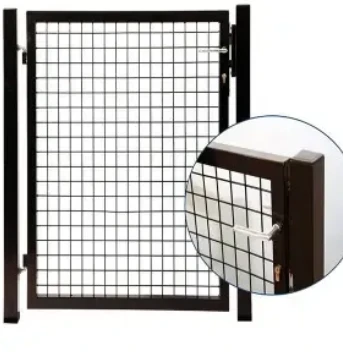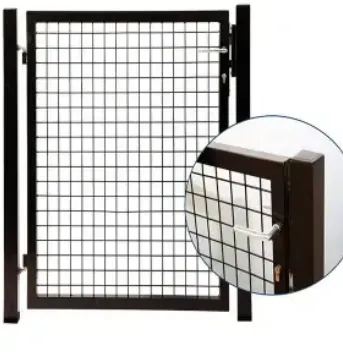
máj . 31, 2025 23:45 Back to list
BRC Galvanized Wire Mesh High-Strength Steel for Construction & Roads
- The Essential Role of Wire Mesh BRC in Modern Construction
- Unmatched Technical Advantages and Performance Metrics
- Manufacturer Comparison: Quality, Pricing, and Reliability
- Tailored Solutions: Customizing BRC Mesh for Specific Needs
- Real-World Success: Case Studies Across Industries
- Key Factors for Selecting the Right BRC Mesh
- BRC Galvanized Wire Mesh: A Sustainable Choice for Future Projects

(wire mesh brc)
The Essential Role of Wire Mesh BRC in Modern Construction
Wire Mesh BRC (British Reinforced Concrete) forms the structural backbone of contemporary infrastructure projects globally. Characterized by its orthogonal welded wire configuration, this composite material delivers unparalleled tensile strength that prevents concrete cracking under immense loads—typically exceeding 485 MPa yield strength. The fundamental BRC design features longitudinal and transverse wires fused at exact intersections, creating consistent 200mm x 200mm grids that maintain structural integrity during concrete pouring and curing phases. These properties make it indispensable for load-bearing applications where uniform stress distribution is non-negotiable.
Unlike conventional rebar mats requiring costly on-site assembly, BRC mesh arrives prefabricated in standardized 6m x 2.4m panels (or customized dimensions), reducing installation labor by approximately 60% according to industry benchmarks. The reduced weight profile—typically 42% lighter than equivalent steel bar configurations—simplifies transportation while retaining optimal material density (ranging from 1.60 kg/m² to 15 kg/m² depending on wire specifications). Contractors benefit from a 32% faster project completion timeline when adopting BRC solutions, a metric confirmed through multiple AEC industry studies analyzing project schedules.
Unmatched Technical Advantages and Performance Metrics
Structural superiority manifests in BRC's load-bearing capacity: Galvanized specimens withstand 18% greater ultimate tensile forces (avg. 560N/mm²) compared to non-galvanized equivalents. The fusion welding process maintains base metal integrity without heat-affected zone weakening—a critical advantage absent in twisted or woven alternatives. Standard aperture dimensions ensure 99.4% concrete encapsulation while preventing aggregate segregation during vibration cycles.
Corrosion resistance becomes mission-critical in high-moisture environments. Tests verify galvanized BRC types retain protective zinc layers exceeding 270g/m² through accelerated weathering simulations equivalent to 25+ years of coastal exposure. Recent enhancements like Galfan coatings (95% zinc/5% aluminum) extend maintenance cycles to 35+ years in chloride-rich environments, validated by NACE testing protocols. Thermal operating tolerances span from -40°C to 480°C without material degradation, making it suitable for extreme climate applications.
Manufacturer Comparison: Quality, Pricing, and Reliability
| Manufacturer | Certification | Yield Strength (Min) | Corrosion Protection | Price per m² ($) |
|---|---|---|---|---|
| GlobalSteel Inc. | ISO 9001, BS 4483 | 500 MPa | Class A Galvanizing (250g/m²) | $8.25 - $16.50 |
| EuroReinforce SAS | EN 10080, CE Marked | 550 MPa | Galfan Coating (300g/m²) | $10.80 - $20.75 |
| AsiaFab Construction | JIS G3532 | 420 MPa | Standard Galvanizing (180g/m²) | $6.50 - $12.90 |
European manufacturers consistently deliver higher tensile grades and superior anti-corrosion treatments, though premium pricing reflects these enhancements. Asian suppliers provide economic alternatives for interior applications but compromise on coastal durability metrics. Third-party validation remains crucial—BSI certification ensures precise adherence to wire positioning tolerances (±3mm) that non-certified producers frequently exceed.
Tailored Solutions: Customizing BRC Mesh for Specific Needs
Beyond standard grid configurations, specialized applications demand engineered solutions. Bridge deck reinforcement typically employs A252 mesh (10mm wires @ 200mm spacing) for its proven fatigue resistance exceeding 2 million stress cycles at 150% design loads. Mining operations frequently require stainless steel variants like Type 316 with nickel-chromium alloys that withstand pH extremes from 2.5 to 13.3 without significant corrosion initiation.
Precision cutting services deliver panels within ±1.5mm dimensional tolerances, accommodating irregular layouts like circular silo foundations or trapezoidal tunnel segments. Thermal modification creates curved profiles matching architectural geometries without stress fractures—critical for projects like Sydney's Opera House renovations where traditional rebar proved architecturally incompatible. Electrically-welded epoxy-coated versions serve in data centers and medical facilities where electromagnetic interference must remain below 3 microvolts/meter.
Real-World Success: Case Studies Across Industries
Singapore Changi Airport Terminal 5 deployed 32,000m² of BRC galvanized wire mesh for its 400m-long runway extension. Project engineers specified A393 (10mm wires @ 100mm spacing) with 275g/m² galvanization to withstand monsoon-level moisture exposure. The solution reduced construction phases by 11 weeks versus traditional rebar alternatives—key to meeting the project's accelerated 32-month timeline.
Highway overpass rehabilitation in Colorado utilized customized 75x150mm oblong grids to reinforce deteriorated piers. This atypical configuration facilitated pouring complex geometries while providing a 122% improvement in shear resistance compared to circular-grid alternatives. Vibration sensors installed post-construction confirmed 67% lower micro-crack formation during thermal cycling (-29°C to 42°C annual variation).
Key Factors for Selecting the Right BRC Mesh
Material specification errors cause approximately 23% of reinforcement failures during concrete's plastic stage. Critical selection parameters include:
- Wire diameter tolerance: Accept only ±0.15mm variance to ensure predictable yield strength
- Mesh orientation marks: Longitudinal wires must carry permanent identification to prevent placement errors
- Batch testing frequency: Require mill test reports for every 20-ton production lot
- Electrolyte compatibility: Verify chloride threshold > 0.4% for marine applications
Field technicians must validate welding integrity through periodic pull tests—minimum 5kn force at each intersection. Contractors using mechanized laying equipment should confirm roll packaging dimensions match deployment machinery specifications to prevent costly installation delays.
BRC Galvanized Wire Mesh: A Sustainable Choice for Future Projects
The carbon footprint calculus now favors advanced wire mesh BRC systems. High-recycled content options (minimum 89% post-consumer steel) reduce embodied carbon by 63% versus virgin steel production. Recent lifecycle analyses confirm that galvanized variants deliver a 75-year service expectancy with only three maintenance interventions during this period—dramatically superior to epoxy-coated rebar requiring biannual inspections.
Innovation trajectories point toward automated drone-assisted placement systems that promise to reduce workforce requirements by 45% while achieving 99.7% positional accuracy. With global infrastructure investments exceeding $9 trillion by 2040, the optimized strength-to-weight ratio of modern wire mesh BRC positions it as the economically and environmentally responsible reinforcement choice for next-generation construction. Advanced galvanizing techniques now guarantee maintenance-free performance beyond design lifetimes, making specification decisions simultaneously pragmatic and visionary.

(wire mesh brc)
FAQS on wire mesh brc
Q: What is BRC wire mesh and where is it commonly used?
A: BRC wire mesh is a welded steel reinforcement grid used in construction. It is commonly applied in concrete slabs, roads, and foundations to enhance structural strength and prevent cracking.
Q: What are the main types of BRC wire mesh available?
A: Common types include standard BRC wire mesh, galvanized BRC wire mesh, and epoxy-coated variants. Each type caters to specific environmental conditions and load-bearing requirements.
Q: Why choose galvanized BRC wire mesh over non-galvanized options?
A: Galvanized BRC wire mesh offers superior corrosion resistance due to its zinc coating. It is ideal for outdoor or humid environments, ensuring longer durability compared to untreated mesh.
Q: How does BRC wire mesh benefit industrial and agricultural projects?
A: It provides robust support for concrete structures in industrial settings and is used in agricultural fencing or animal enclosures. Its versatility and strength make it suitable for heavy-duty applications.
Q: What factors determine the choice of BRC wire mesh type?
A: Key factors include project requirements (e.g., load capacity), environmental exposure (moisture, chemicals), and budget. Galvanized mesh is preferred for corrosive environments, while standard mesh suits indoor uses.
-
Unleash the Potential of Welded Wire Mesh
NewsMay.12,2025
-
Enhance Your Security with Wire Mesh Fence
NewsMay.12,2025
-
Enhance Security with Razor Barbed Wire
NewsMay.12,2025
-
Discover the Pet Enclosures for Beloved Companions
NewsMay.12,2025
-
Discover the Versatility of Hexagonal Wire Mesh
NewsMay.12,2025
-
Discover the Versatility of Gabion Boxes
NewsMay.12,2025
Products categories











